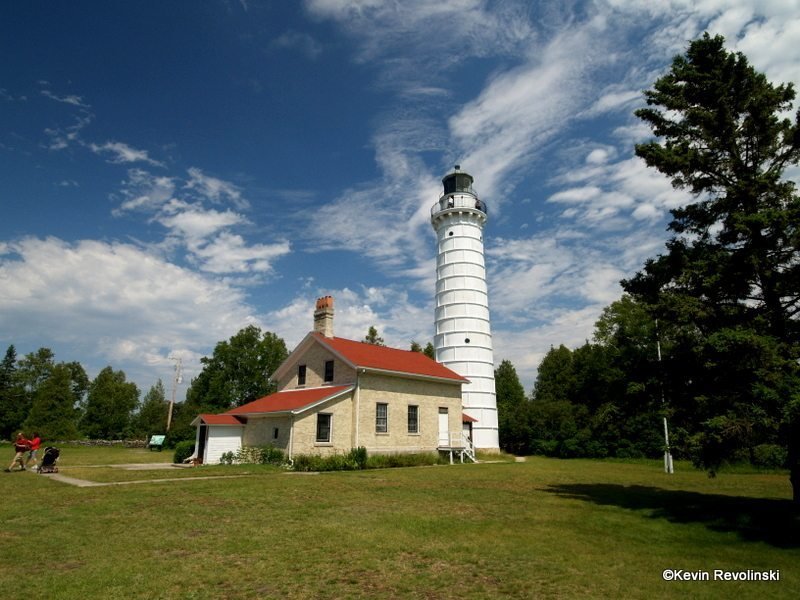Visiting the Lighthouses of Door County
 The door resembles a bulkhead and I duck and ease myself out. The sudden force of the wind compels me to tuck my baseball cap into my jacket pocket. Over the rail I look down at the little people in the yard looking up. Beyond them the white-tipped waves march in, row by row to shore, and I can see for miles up and down the coastline. The sun has broken through again and the cumulus clouds seem to mimic the lake with their own relentless current. The crisp air, the scent of cedars, pines and lakewater, and the bright white of tower, wave and cloud in the afternoon sun amount to a marvelously vivid sensory experience.
The door resembles a bulkhead and I duck and ease myself out. The sudden force of the wind compels me to tuck my baseball cap into my jacket pocket. Over the rail I look down at the little people in the yard looking up. Beyond them the white-tipped waves march in, row by row to shore, and I can see for miles up and down the coastline. The sun has broken through again and the cumulus clouds seem to mimic the lake with their own relentless current. The crisp air, the scent of cedars, pines and lakewater, and the bright white of tower, wave and cloud in the afternoon sun amount to a marvelously vivid sensory experience.
Standing at the top of Cana Island Lighthouse is like being at the helm of an amazing ship. Titanic be damned; this is a true king-of-the-world feeling as wind and water whirl around you. And until recently, this experience was only possible one weekend out of the year.
Lighthouses, intended to help ships avoid disaster, have the unintended role of tourist attraction. We romanticize them, photograph them, and what else? Climb them.
 The jagged shores of Door County, the peninsular thumb of Wisconsin’s mitten, were once – and still can be – a sailor’s nightmare. The name itself comes from Porte des Morts or Death’s Door, for the passage between the mainland and Washington Island just off the northernmost point. The abundance of shoals and the fickle moods of Lake Michigan demanded a good system of warning lights.
The jagged shores of Door County, the peninsular thumb of Wisconsin’s mitten, were once – and still can be – a sailor’s nightmare. The name itself comes from Porte des Morts or Death’s Door, for the passage between the mainland and Washington Island just off the northernmost point. The abundance of shoals and the fickle moods of Lake Michigan demanded a good system of warning lights.
In all there are ten lighthouses in Door County. While most can only be seen from the outside—by car or by boat—three can be toured seasonally: Eagle Bluff Lighthouse, Pottawatomie Lighthouse, and Cana Island.
Cana Island is home to the quintessential lighthouse: the 90-foot-tall tower painted a gleaming white, a red-roofed keeper’s home attached at the base, and the surrounding restless waters alternatively lapping or pounding at the rocky shore just outside the stone wall of the yard.
 The 8.7-acre island rests between Moonlight Bay and North Bay just north of Baileys Harbor, but thanks to low lake levels, “island” seems a misnomer; barring a big storm there is no threat of getting one’s feet wet on the short trek across the causeway, a narrow spit of loose rock and sand.
The 8.7-acre island rests between Moonlight Bay and North Bay just north of Baileys Harbor, but thanks to low lake levels, “island” seems a misnomer; barring a big storm there is no threat of getting one’s feet wet on the short trek across the causeway, a narrow spit of loose rock and sand.
Mike Chisolm gives tours at the lighthouse. “Welcome back to 1869,” he says as he shows me the former keepers’ living quarters. The pantry and kitchen are shown as they once were, while the living room and parlor have become the welcome center and gift shop. The exhibits chronicle the structure’s history and the stories of the keepers. The keeper’s office houses photos and audio exhibits while the second floor offers more photography and a couple of short videos.
 Chisolm uses a hands-on prism exhibit to demonstrate how a lighthouse works. Remarkably, the bulb itself is the size of my little finger, but a Fresnel lens uses prisms to refract the light in one direction making it visible 15 to 18 miles away. Cana Island’s is a third order lens, on a scale of six. (The first order is the largest)
Chisolm uses a hands-on prism exhibit to demonstrate how a lighthouse works. Remarkably, the bulb itself is the size of my little finger, but a Fresnel lens uses prisms to refract the light in one direction making it visible 15 to 18 miles away. Cana Island’s is a third order lens, on a scale of six. (The first order is the largest)
While the light was once powered by kerosene, the keepers used wood stoves for heat and cooking. “We’ve since been modernized, so now there’s no heat whatsoever out here,” says Chisolm. Cana Island has been automated since 1944 and operated by the U.S. Coast Guard.
 Just south of Cana, closer to Baileys Harbor are the Range Lights. When lined up from offshore, these two towers help navigators take bearings. Though there are no tours inside the structures the setting is The Ridges Sanctuary, a boreal forest preserve with unusual land formations like ripples in the earth that show the evolution of the shoreline over thousands of years.
Just south of Cana, closer to Baileys Harbor are the Range Lights. When lined up from offshore, these two towers help navigators take bearings. Though there are no tours inside the structures the setting is The Ridges Sanctuary, a boreal forest preserve with unusual land formations like ripples in the earth that show the evolution of the shoreline over thousands of years.
On the other side of the peninsula between Fish Creek and Ephraim is Peninsula State Park and the Eagle Bluff lighthouse which guided traffic through the shipping channel between the mainland and some shoals not far offshore. Built in 1868, Eagle Bluff’s 43-foot-tall light and its attached house were home to keepers and their families until the light became automated in 1926. Now travelers can join guided tours of the two-story house. A similarly designed tower on Chambers Island stands sentinel over a more westerly passage straight out from the viewpoint here, but it is only reachable by boat.
For the serious lighthouse enthusiast there is Pottawatomie. Originally completed in 1837, this was the first Wisconsin lighthouse on Lake Michigan. A second construction replaced it in 1858, but in 1988 it too was dismantled. Friends of Rock Island, however, wouldn’t stand for it and the rebuilt lighthouse there today is the fruit of their efforts. Volunteers take weeklong turns staying there as guides.
Just getting to the lighthouse will take you a full day, with two ferry crossings and a mile-long hike on the small car- and bike-free island. The visit may also require you to camp overnight at the state park. But to see this remarkably remote place where one former keeper actually lived alone for 15 years is well worth the effort.



 ORDER YOUR COPY TODAY!
ORDER YOUR COPY TODAY! ORDER YOUR COPY TODAY!
ORDER YOUR COPY TODAY!